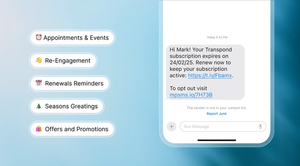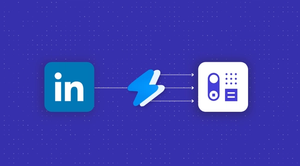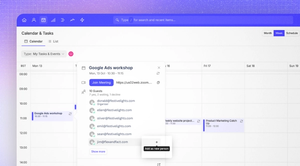Picture the scene: You’ve had a good sales call. The prospect matches your ideal customer profile (ICP) and they sound interested. Maybe you even send a proposal over. Then something else comes up. You forget to check in. A week goes by, then a month. Just like that, the momentum’s gone and you’ve lost the sale.
Most of the time, it’s not the product, the pitch, or the price that kills a deal. It’s the silence.
More important than any sales “hack” or closing technique, you need a way to follow up consistently.
With the right software, you can make sure every prospect hears from you at the right time. Capsule CRM makes following up with prospects and customers easy, doing all the legwork for you so you can stay on top of your sales conversations.
In this guide, you’ll learn how to set up Capsule to handle follow-ups for you, using features like Tracks, Task reminders, Workflow Automation, and more to level up your conversations.
Let’s break down how you can build a complete follow-up system inside Capsule, starting at the simplest level.
Level 1: Use Task reminders to stay in the loop
Capsule’s Task reminders are the easiest way to make sure you never forget a follow-up.
Every task in Capsule comes with a due date. Once it’s in the system, Capsule keeps you in the loop with clear, timely reminders via your dashboard, in-app notifications, and (if you like) email alerts.
When it comes to following up, it means you can set reminders to make a call, write a follow-up email, or send a proposal over. Whether you’re a solo user trying to stay on top of a busy pipeline or part of a team working across multiple opportunities, you’ll always know exactly what needs doing and when.Think of it as your personal assistant, one that never forgets a thing.
You can view your tasks in a daily list, filter by user or opportunity, or sort by task category (helpful if you want to group all your follow-up calls in one go). Because Tasks reminders are baked into every part of Capsule (contacts, opportunities, and projects), they’re always linked to the right conversation.
Here’s what that looks like in practice:
- A new lead comes in. You add a task to call them tomorrow. Capsule reminds you on the day.
- You send a proposal. You create a task to follow up in three days. Capsule makes sure you don’t forget.
- A client asks you to check back next month. You set the task, then move on, leaving Capsule to take care of the timing.
Capsule’s Task reminders are incredibly flexible and easy to set up. You can add tasks in a single click to your Contacts, Projects, or Opportunities when viewing the record in Capsule. If your task is not directly related to any record in Capsule, you can add Tasks in their own right from the Calendar page.
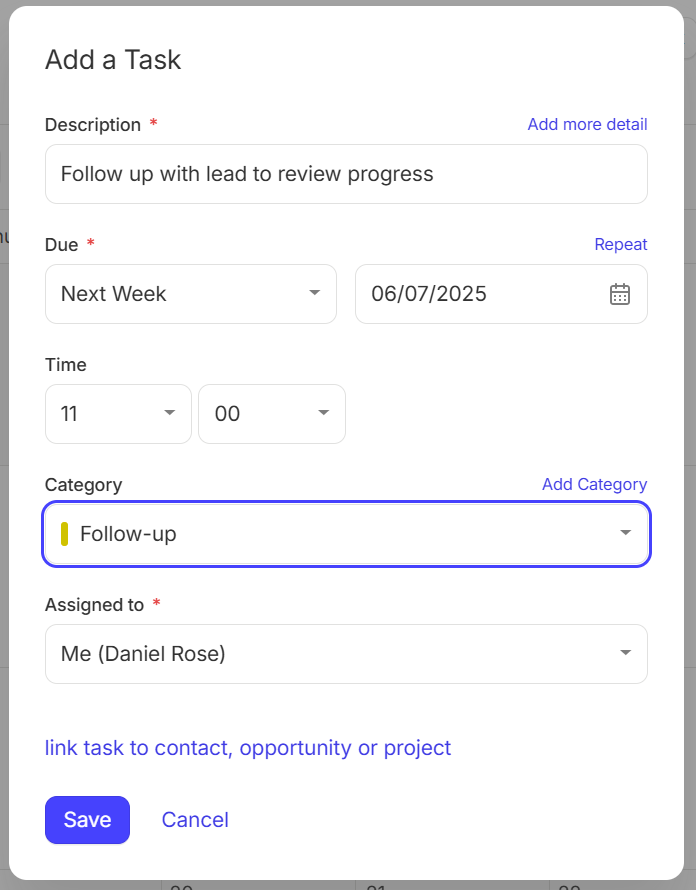
It’s a simple habit, but one that makes a huge difference. With Capsule handling the reminders, you can stop juggling follow-ups in your head and start focusing on what actually moves deals forward.
Level 2: Set up repeating follow-ups using Tracks
Capsule’s Tracks, one of our most popular features, goes beyond manual reminders and lets you create repeatable processes that you can use for every contact.
Tracks enables you to build templated, reusable task lists for any procedure, from onboarding new hires to event planning. Think of them as reusable job lists you can apply to any sales opportunity or project. This makes them perfect for creating a consistent follow-up process.
Once you’ve set up and activated the Track, Capsule schedules your chosen tasks at the right time, without you having to rely on your memory or dig through old emails to see what’s due next.
Let’s walk through a real example of a simple Track:
- Day 0: Send intro email
- Day 2: Follow-up email
- Day 5: Send proposal
- Day 8: Follow-up call if no response.
Just like that, you’ve got a consistent follow-up process, and you won’t need to create these Tasks individually.
But what about if you have a more complex process in mind? Let’s say your sales process typically involves qualification, multiple follow-ups, proposal discussions, and a handoff to onboarding once the deal is closed. In that case, your advanced Track might look like this:
- Day 0
- Send intro email
- Schedule discovery call
- Day 2
- Discovery call with lead
- Log notes and update opportunity stage
- Day 4
- Send recap email with key takeaways
- Day 6
- Schedule product demo
- Day 10
- Product demo
- Add internal note: demo outcomes and objections
- Day 11
- Send proposal
- Day 14
- Follow up if no response
- Update opportunity value or timeline if needed
- Day 18
- Second follow-up to ask if they’re still interested
- If deal marked as Won:
- Send onboarding welcome email
- Handoff to customer success
- Schedule follow-up call in 30 days.
Setting up Tracks is simple. Just go into your Capsule Account Settings and open up the Tracks section. Choose whether you want to create a Track for sales opportunities or projects, then decide on a name. Once you’ve done that, add all the required tasks, with a description, due date, and assignee.
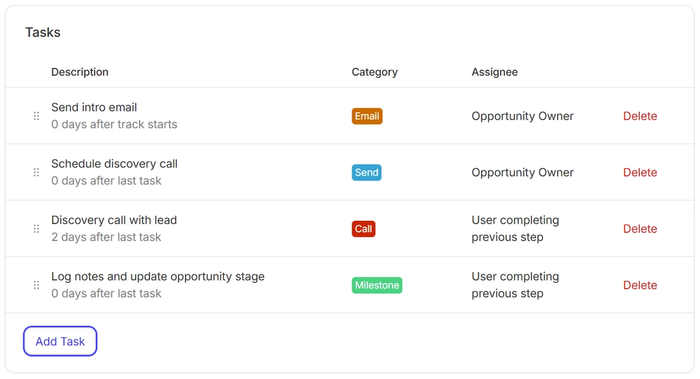
You can add as many tasks as you like and customize due dates based on when the Track starts or when the previous task was completed. Instead of building that process from scratch every time, you create it once as a Track.
Now, whenever a new lead comes in, you can apply the Track and Capsule will queue up each Task for you.
Level 3: Trigger follow-up actions based on deal activity
If Tracks are about creating consistency, Workflow Automation is about taking things off your plate entirely.
Available on Capsule’s Growth plan, the Workflow Automation feature lets you trigger actions based on changes in your data, so you can build in automatic follow-up tasks without having to lift a finger.
For example, you could set up an automation where, when an opportunity is added to the sales pipeline, the system creates a task to follow up three days later.
That might not sound groundbreaking, but it’s the kind of small automation that makes a huge difference. Capsule monitors your contacts, deals, and pipeline for you and then, if anything needs attention, it can give you (or your team) a nudge.
You can use Workflow Automation to tackle those repetitive but essential admin tasks, like assigning new opportunities to team members or sending a welcome email once a deal is marked as won.
If you’re using Tracks, you can even automate those, too. For example, you could automatically apply a Track to every new opportunity that comes in, so Capsule starts your follow-up process immediately.
To set up an automation, just tap on the Workflow Automation section on the top menu ribbon. From there, choose one or more triggers (like a new opportunity being added or a deal being marked as “won”), and define what Capsule should do next, whether that’s creating a project, sending an email, or applying a Track.
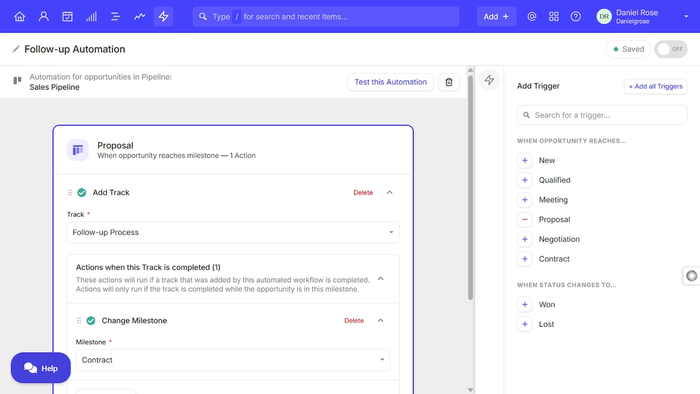
You can also connect Capsule with thousands of other apps using Zapier, then use those connections to create all sorts of useful automations.
Once it’s set up, Capsule takes care of the timing and execution, reducing the mental workload and freeing up more time to focus on high-touch activities.
Level 4: Send follow-up emails directly from Capsule
For most small businesses, email is still the main channel for follow-ups. From simple check-ins to sending proposals, it usually happens in the inbox.
Capsule speeds up the process by letting you send emails directly from the contact or opportunity view. You don’t need to open a separate tab or dig through your inbox; just write the message and send it from inside Capsule. Everything’s automatically linked to the right record.
Compose email window
Capsule works seamlessly with Gmail and Outlook, so you can keep using the email tools you already know.
If you want to speed things up even more, the AI Content Assistant can help write the message for you. You can also create Email Templates for your more common messages, such as:
- A quick “Nice to meet you” note after a discovery call
- Following up on a quote
- Checking in if you haven’t heard back.
Insert template window
Using Capsule for your emails helps keep your team aligned. Every email you send from Capsule is saved to the contact’s timeline, so everyone can see what’s been sent and when. That means no duplicated follow-ups or crossed wires.
Combined with task reminders or automation, this turns Capsule into your full follow-up command center. You get the flexibility of email with a CRM’s structure, so nothing gets lost and no one gets missed.
Never miss a follow-up with Capsule CRM
Silence may kill a sale, but strong follow-ups grow interest. With the right processes in place, you can nurture your leads until they’re ready to take action.
Capsule makes that follow-up as easy as possible. Task reminders keep you on schedule, even on your busiest days. With Tracks, you can build repeatable sales processes that don’t rely on memory. Automations trigger follow-ups when deals stall, and email integration lets you respond faster without jumping between tools.
As a result, leads stay warm, conversations move forward, and you can close more deals.
Try any Capsule plan free for 14 days or sign up for our free plan and create a more effective follow-up process today.


